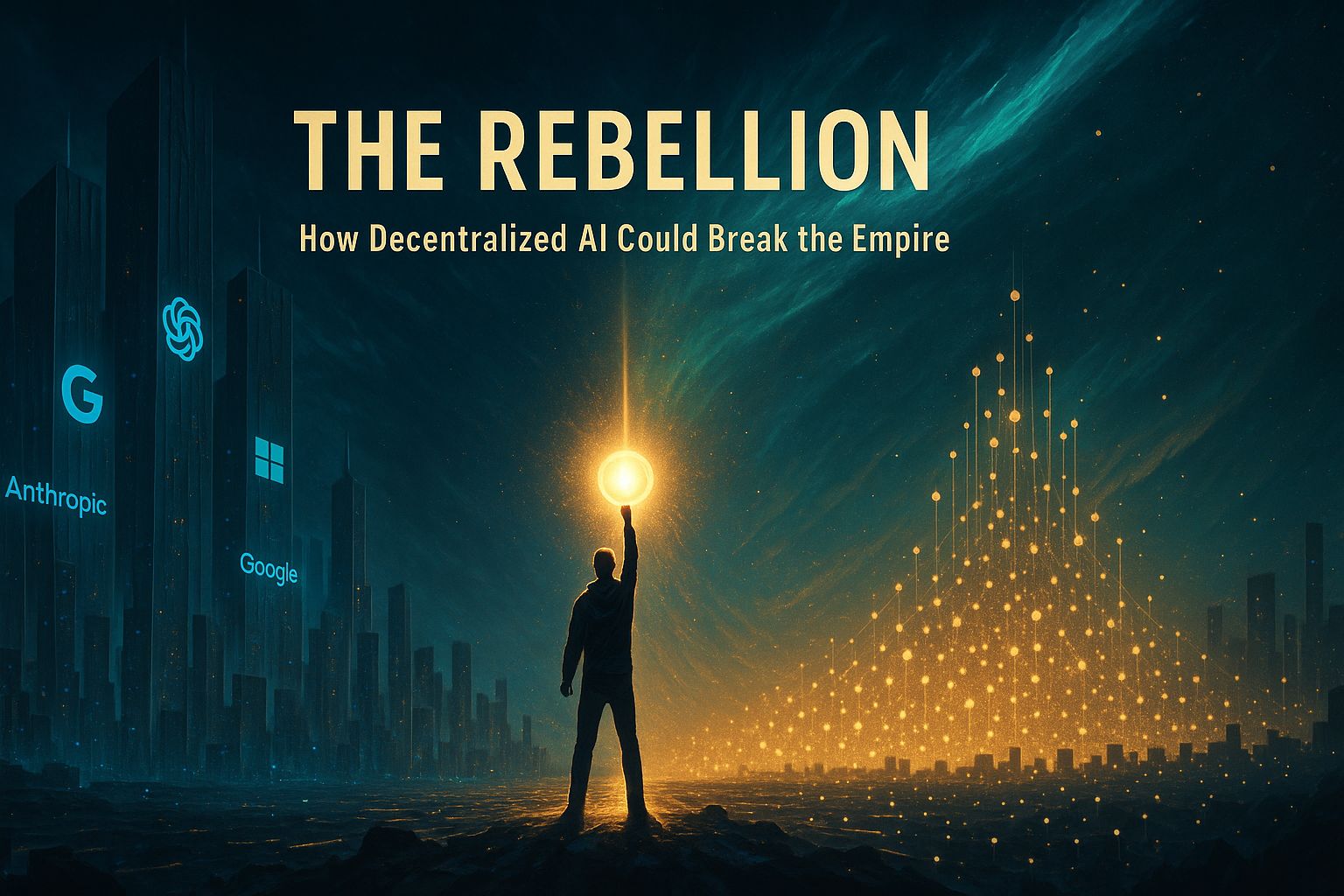- The Human's Codebook
- Posts
- 🧭 The Rebellion: How Decentralized AI Could Break the Empire
🧭 The Rebellion: How Decentralized AI Could Break the Empire
In every age of empire, there comes a moment when the system cracks.

The signs start small — a group of thinkers, a local uprising, a new way of organizing power.
It never looks like a revolution at first.
But it always starts the same way: with people deciding they’ve had enough.
That’s where AI is right now.
The empire has peaked.
And a quiet rebellion is already underway.
⚙️ The Empire’s Core Weakness
In Part 1, we talked about how OpenAI, Google, Anthropic, and Microsoft built digital empires.
They control data, models, compute, and narrative.
But every empire eventually becomes its own bottleneck.
The bigger it gets, the slower it moves.
The more power it hoards, the less it can see.
That’s exactly what’s happening in AI.
Closed models limit innovation.
Corporate secrecy erodes trust.
Centralized data creates security and ethical risks.
The very structure that made these companies powerful is now their greatest vulnerability.
And into that gap steps something new — something decentralized, transparent, and unstoppable.
🌍 The Rise of Decentralized AI
Let’s be clear: decentralization isn’t about chaos.
It’s about control — who gets to have it.
Right now, the AI ecosystem looks like a pyramid:
At the top, a handful of labs own the models.
In the middle, startups build on their APIs.
At the bottom, billions of users feed them data.
But what happens when the pyramid flips?
That’s the promise of decentralized AI — where compute, data, and decision-making are distributed across many hands, not owned by a few.
Think of it as the internet’s second revolution — the same way the web broke media monopolies, decentralized AI could break data monopolies.
🧠 What Decentralization Really Means
There’s a lot of noise around this term, so let’s make it simple.
Decentralized AI isn’t just one technology. It’s an approach built on three pillars:
1️⃣ Open Models
Instead of billion-dollar closed models like GPT-4, open-source versions (like Mistral, LLaMA, or Falcon) are trained transparently and shared publicly.
They may start smaller — but innovation compounds when everyone can build on top of them.
Open-source is how Linux beat Windows in servers.
It’s how Stable Diffusion outpaced DALL·E in art.
It’s how communities beat corporations, again and again.
2️⃣ Community Data
Imagine data owned by communities, not corporations.
Indigenous groups building language models to preserve culture.
Local hospitals training health models without giving data to big tech.
Projects like Te Hiku Media and The DAIR Institute already prove this model works
Empire of AI Dreams and Nig_…
.
They’re small, but powerful — because they represent something bigger: self-determination in the age of algorithms.
The biggest barrier in AI isn’t talent — it’s GPUs.
That’s where decentralized networks like Bittensor or Gensyn come in — pooling global compute power from individuals, researchers, and small labs.
Instead of one company owning all the chips, imagine a compute marketplace — where anyone can contribute processing power, earn tokens, and train models collectively.
That’s not science fiction. It’s already happening.
⚔️ The Empire Strikes Back
Of course, the empire won’t go quietly.
Big Tech will fight to keep control — through lobbying, acquisitions, or regulation disguised as “safety.”
They’ll argue that decentralization is dangerous.
That open models will be misused.
That only centralized control can prevent chaos.
But here’s the truth:
Centralization is the chaos.
It’s what causes data monopolies, job displacement, and bias to scale globally.
It’s what allows five companies to dictate what “responsible AI” even means.
History is clear — power doesn’t give itself away.
It’s taken back, piece by piece.
🌱 The Blueprint for the Rebellion
Here’s how this shift will happen — not overnight, but inevitably:
Open ecosystems will out-innovate closed ones.
When thousands of independent developers can experiment freely, breakthroughs multiply.Regulation will catch up.
Governments will start demanding transparency, forcing Big Tech to share datasets and model information.AI infrastructure will fragment.
Instead of one “internet of AI,” we’ll see networks of smaller, specialized AIs built for specific communities or industries.Capital will follow the builders.
Investors will realize there’s more growth in empowering 10,000 smaller players than defending one empire’s walls.
That’s the direction of gravity now — away from centralization, toward collaboration at scale.
💡 The Human Layer
Here’s the part everyone forgets: technology doesn’t decentralize itself.
People do.
Decentralized AI isn’t just about software — it’s about values.
It’s about giving creators ownership of their work, researchers freedom from corporate NDAs, and users the right to understand the systems that shape their world.
This movement is powered by belief — the same kind of belief that once built the empire, now fueling its undoing.
That’s the paradox of progress:
The same idealism that concentrated power can also break it.
🔮 What Comes After the Empire
The fall of an empire doesn’t mean collapse.
It means rebirth.
What comes after won’t look like one giant AI.
It’ll look like millions of smaller intelligences, each serving local needs, languages, and dreams.
Instead of one model trying to “benefit all of humanity,”
we’ll have thousands built by humanity — for humanity.
And that’s the real promise of decentralization:
AI not as an empire, but as an ecosystem.
⚙️ Final Thought
The empire of AI was built on three words: Scale is everything.
The rebellion will be built on three new ones: Power to people.
The question isn’t whether decentralization will happen — it’s how fast.
Because in the long run, open always wins.
Empires make the world efficient.
Rebellions make it alive.
And the next chapter of AI won’t be about domination.
It’ll be about distribution.
🚀 The rebellion has begun.
And this time, the algorithm serves us — not the other way around.